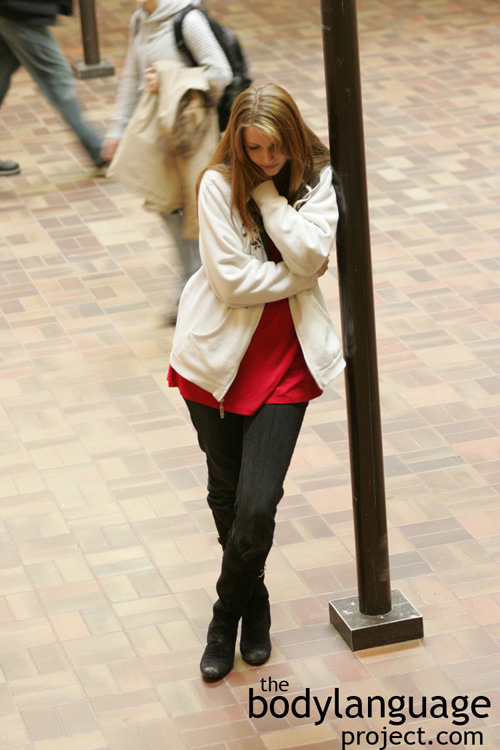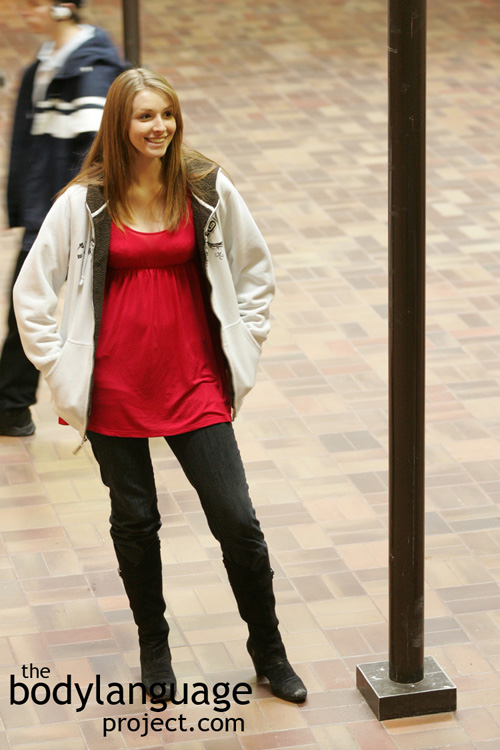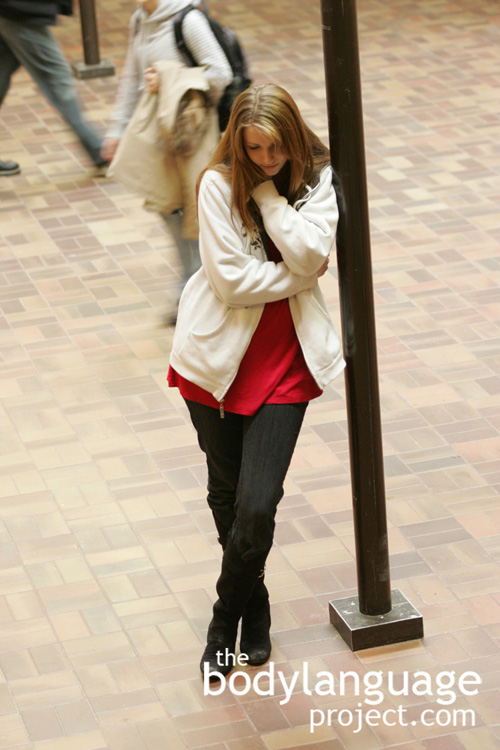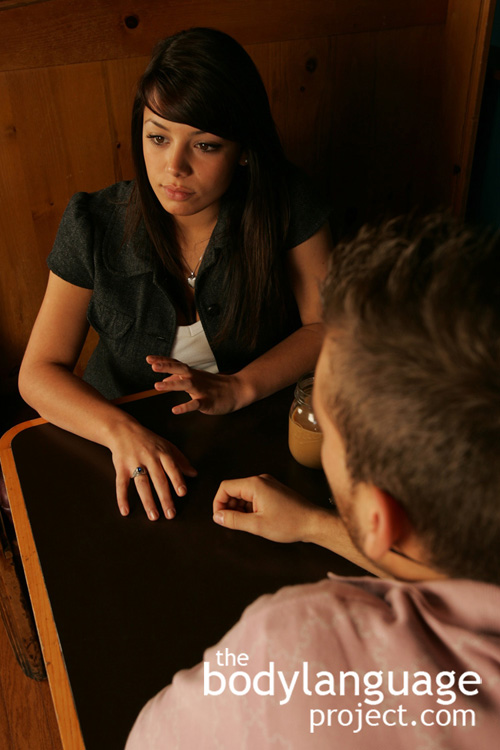In this chapter we looked in depth about space or territory and how it influences body language. We learned that the term applied to how people use space is proxemics and it includes personal space, distance norms, how cultures and regionality such as rural and urban centers are reflected in personal space, and how they relate to status and context. We learned why people turn into zombies in crowded city streets, how eye contact can control intimacy and why we should respect people’s personal space comforts no matter where they hail. We then played the urinal game and showed how space ties together with this ritual, and finally we covered indicators of invasion which can help us in respecting space limitations when in novel situations, or when around new acquaintances.
Tag Archive for Eye Contact
Space And Eye Contact
by Chris Site Author • March 5, 2013 • 0 Comments
You can imagine that strangers walking about in public want to maintain a certain degree of separation between one another. This can and is achieved through eye contact. Reducing or preventing eye contact is a way to tell other people that they wish to maintain their space and privacy, and do not wish to communicate with others. Eye contact is a function of intimacy and has been referred to as part of the equilibrium state. That is, eye contact is one component that controls the degree of intimacy, the other is distance. By controlling one or the other, or both, we can control aspects of our equilibrium state, or intimacy, such as whether it will start at all, and how or when it should end. You can imagine that full intimacy can not happen at great distances although telephones and web technology attempt to do otherwise. Each fails miserably and does intimacy no justice.
As distance increases, intimacy decreases so you can imagine that strangers would feel freer to glare at others from say, across the road, but as they near the point at which they intersect they will drop or avert their eyes so as to eliminate intimacy. Therefore, that which gives permission for staring is distance and that which protects intimacy is eye contact. To have real intimacy both proximity and eye contact must be present. By this argument, city people aren’t rude at all, they are just doing what is normal, avoiding unwanted intimacy from strangers. Rural settings where there is a real possibility that you actually know the person on the street, or know a relative of the person is large, so intimacy is not only permitted by also safe. Eye contact in the city can send the wrong message to the wrong person inviting unwanted contact.
To illustrate this point imagine a women who is happily married but otherwise attractive to men. Upon entering a coffee shop, she turns the heads of men. When she notices that she is being watched, she averts her gaze and instead of making eye contact she ‘looks over the heads of others’ or possibly even looking down her nose at them by tilting her head backward showing disapproval. She sends a disinterested message, an “I’m taken.” If startled, she might inadvertently make eye contact with a stranger but she will instinctively drop her head and avert her gaze sideways, being careful to make no emotion facial expressions. In doing so, she avoids emitting the wrong message and therefore prevents unwanted solicitation. Men are often victims of assuming any eye contact is flirtatious, even if it happens by accident, thus women are generally careful of whom they look at directly. Some women learn this through a bad experience; others seem to know it instinctively. Men can test this out for themselves by trying to secure eye contact with women as they pass them on the street. Men are rarely able to secure eye contact from strangers and it’s usually not for a lack of trying.
People As Objects
by Chris Site Author • March 5, 2013 • 0 Comments
This is why city streets are flooded with strangers behaving like zombies with expressionless faces as they hurry about. City folk seem inhuman and unemotional, detached, despondent and more than anything else, from an outsider’s perspective, they appear unhappy. Contrast this with a small city where eye contact is met with smiles, nods or waves and where doors are held open for others with words such as “thank you” provided in exchange.
So why do busily moving city slickers seem as though they are moving about a forest of trees, instead of a sea of actual living human beings with emotions and feelings? Why do city slickers dehumanize themselves? The answer lies in phenomenon termed “masking.” Masking is a coping strategy used to detach ourselves from our bodies so as to avoid negative feelings as we intrude on the personal space of others and as our personal space is intruded upon. Sometimes we even mask with outwardly aggressive emotions typified by New York streets. Cussing, yelling and other carrying on is a way to mask sensitivity and to hide caring. This is not to say that one becomes less human in New York, it just means that you can’t appear to be a wimp.
Masking helps people protect themselves from their emotions and is so potent that it is difficult sometimes to snap people from this hypnosis. Sometimes even making eye contact with others can be seen as offensive and returned only with an expressionless face, a glare, or even a snarl as if implying that the issue is that of another and not theirs.
Just like country folk expect and appreciate amicable greetings, smiles, waves and nods, city slickers expect and appreciate emotionless faces, few or no greetings and for people to mind their own business. Don’t confuse either situation for anything other than a coping mechanism. Taken in similar context, you might just see how similar each breed of people really is.
Here is a breakdown of ways we act in crowded places like subways and elevators:
[A] We stand or sit still, unmoving. The more crowded the area, the more frozen we remain.
[B] The face becomes blank and expressionless, but it is not due to negative thoughts but rather as a coping mechanism.
[C] Eye contact is avoided by looking at the floor or ceiling.
[D] Books, newspapers and other devices appear particularly interesting and immersive, serving to detach the self emotionally from the situation.
[E] Under extremely crowded conditions where touching is unavoidable, bodies appear to jostle to make space and if possible only allow shoulders and elbows to touch.
How To Use Regulators
by Chris Site Author • March 5, 2013 • 0 Comments
Regulators, regulate speech and control turn taking. Literally we can increase or decrease the amount of talking that happens with simple body language. For example, to increase speaking add more nodding. When people stop and you wish for them to continue simply nod your head, and, more often than not, this will encourage them to begin speaking again. The use of “mhums” and “yeses” will have the same effect. To speed speech up, or end a conversation altogether, send frequent looks away or down to your watch.
Too much nodding, on the other hand, shows indifference which can be a useful tactic depending on the speaker and your intent. Three nods in quick succession shows that you are ready to speak yourself and has the net effect of increasing their rate of speech to avoid being cut off. Drawing in air and parting the lips while tilting the head back slightly also gives the impression that someone is prepared to speak, as does patting the mouth with two fingers. Looking at your watch or looking to the doorway will make people talk less or if done excessively stop altogether.
Try this experiment. As your conversation begins nod your head every few seconds or as you see agreement. Next, increase the rate at which you nod your heard regardless of any agreement. What happens when you increase your nod frequencies? Most likely, up to about two to three continuous nods, they will become more excited believing they are building rapport. What if you nod continuously? I suspect it will stop the conversation altogether. Recall that three quick nods means that you wish to interject, while continuous nodding comes across as feigned agreement sending the conversation into a standstill. What happens with appropriate nodding absent of proper eye contact? This signals to others that their conversation is falling on deaf ears, and will be taken as an insult. The same goes with random nodding that has lost synchrony with speech. Telephone conversations easily fall off their rails if one party becomes preoccupied with another task. We immediately sense that their regulators have become unlinked from the conversation and when it comes time for them to speak, we hear nothing in return, or there is a delay. Not surprisingly, we find that the person on the other end is watching television – an obvious insult.
When people near the end of their though, and wish for their partner to speak, they will often lower their volume and slow their voice down slightly. Other times, the final syllable will be drawn out or gesturing with the hands will become less frequent or stop altogether. The eyes too are often lowered along with the head but at the very last moment eye contact will resume indicating that it’s time for the other person to begin speaking.
Raising the index finger can also signal a desire to speak which we learn early on in grade school which is normally accompanied by a sharp and deep intake of air. To stifle the “index finger interjector”, extend your hand across and make light contact with their forearm. This is a polite nonverbal way to show that you acknowledge their desire to speak, but that you haven’t quite concluded your point. If you sincerely wish to communicate interest and increase speaking, add a slight head tilt and a half frown or half-smile. This shows the speaker that what they have said is unclear but that you otherwise find it fascinating and wish to learn more.
Good communicators will make great partners amongst all types of speakers, even those that seem to carry on endlessly or those with little to say. They will have a strong arsenal of tools to cut one set of speaker off nonverbally, or as the case may be, encourage them to speak further. While we may take regulators for granted, conversations would be awkward and disjointed without them. Experiment a little for yourself and see how you can modify behaviour with regulators to suite your needs.
Body Language Of Children
by Chris Site Author • March 5, 2013 • 0 Comments
 Babies are almost entirely dependant on nonverbal communication in their first few months, that is, if we discount crying! As children age, they still rely, as adults do, on nonverbal language such as pointing at a toy rather then asking for it, pushing other children aside when it suites them, or even hugs to show affection and exaggerated pouting to garner sympathy. Babies as young as nine month’s old, who lack verbal language, can even begin using sign language to convey desires showing just how rooted non-verbal communication is all of us.
Babies are almost entirely dependant on nonverbal communication in their first few months, that is, if we discount crying! As children age, they still rely, as adults do, on nonverbal language such as pointing at a toy rather then asking for it, pushing other children aside when it suites them, or even hugs to show affection and exaggerated pouting to garner sympathy. Babies as young as nine month’s old, who lack verbal language, can even begin using sign language to convey desires showing just how rooted non-verbal communication is all of us.
When young children lie they often have troubles making eye contact or they might hang their head, appear tense or they might even quickly pull both hands up and cover their mouths as if to shove the lie back in from where it came from. Even some adults will perform these gestures if they let slip a secret or particularly juicy piece of gossip in the wrong circle. However, at other times, both children and adults are not as obvious. A 2002 study by Victor Talwar and Kang Lee out of the University of Queens, Canada, however, showed that children as young as three are naturally adept at controlling their nonverbal language as it applies to deception. In the study, children were able to fool most of the evaluators of their deception as a videotape showing the lie was replayed. Children are not particularly skilled at lying through verbal channels though, and they slip up easily revealing inconsistencies in their stories, so this is where you can really catch them. We will cover deceptive body language at lengths later on.
Other emotional body language emitted by children is much more prevalent. For example, children use slouching and pouting to show that they are upset and disappointed but as we age, we drop our nonverbal cues in favour of verbal expression. We naturally become more adept at repressing what our bodies do and tend to use more conscious thought and spoken words since it is more direct and less easily misinterpreted. What starts off as a quick mouth slap movement to the mouth when lying (or swearing) in children, slowly becomes a touch to the corner of the mouth. Later, restraint forces the finger to the side even further and then instead of touching the mouth it touches the side of the nose instead. As people age, they become much more difficult to read. By logical progression, the hardest to read of all are sixty-year-old politicians!
As an interesting aside, dedicated parents even claim to be able to sense when a baby is about to relieve themselves and so avoid messy diapers. This technique is referred to as elimination communication. By reading gestures such as frowning, squirming, fussing or tensing, mother’s (or fathers!) in combination with baby’s particular rhythms, can detect when potty time is immanent. Once the baby’s cues have been deciphered the mother can anticipate potty time by holding baby over the toilet and cuing with “hiss-hiss” or “wiss-wiss” sounds. To associate the hissing sounds with urination, this process must be repeated ten to twenty times each day!
The Rule Of Four
by Chris Site Author • March 5, 2013 • 0 Comments
The rule of four, and it’s an important one, says that you can’t attach meaning to a single gesture and accurately judge a person. The rule of four calls on us to read cues alongside other cues commonly referred to as “cue clusters” before drawing conclusions. The more cues that appear in association with other cues, the more accurate one can be about the underlying meaning. It isn’t impossible to see cue clusters in the six’s and sevens or higher. However, most agree that four independent signals is enough to positively identify true meaning.
Sitting with arms tightly pressed against the chest can mean that a person is uncomfortable, but it can also mean that a person is cold! Scratching the nose or face can mean that a person is lying or it could actually have an obvious purpose; to alleviate an itch! However, touching the nose, wiping the mouth in a down-stroke, avoiding eye contact and fidgeting tells us that something dishonest is probably going on. Another example of a cue cluster is as follows: crossing the legs by bringing one foot over the opposite leg (the figure-four leg cross), fingers interlinked together (steepling), leaning back in the chair, and tilting the head back and looking down through the nose at others. This cluster shows arrogance and superiority. However, just the figure four, which is a mild crotch display on its own, means very little. The figure-four-leg-cross only tells us that the crotch has been put on display, but does not necessarily attach meaning to the gesture and indicate arrogance. To some, this posture might not even mean that, it just may be a comfortable way for them to sit.
In all cases, gestures are just gestures and nothing more. It is our targets, the creators, who, knowingly or accidentally, attach meaning or emotions to gestures; it is the senders who are in charge of the delivery phase, and we, as readers, who are in charge of the deciphering phase of the transaction. In other words, it is the sender who is responsible for the message and the meaning entirely, the reader is a passive entity that should never project meaning, especially from that which is not present. That’s not to say that a reader would try to create emotions inaccurately, as this would be counterproductive, but rather that it would be a mistake to bring a gestures to the consciousness of a target and then try to persuade them that their intentions are different from that which is actually true. In many cases, however, you may find that targets won’t be aware of their true emotions anyway and will generally be uncomfortable to be made aware of their subconscious gestures, so reads are best kept to one’s self. Just like you wouldn’t show your cards in poker game, you shouldn’t actively show off your body language skills. Reads, and the skills in this book, are much more powerful if kept a secret.
Not all body movement has hidden meaning either. Sometimes our bodies are quiet and do no talking at all. It is normal for novice readers of body language to immediately begin to see body language cues creep into consciousness, but it’s a mistake to assume that all gestures suddenly have hidden meaning and get carried away with reckless diagnosis.
Let’s take another cue cluster: arms crossed tightly over the chest, legs crossed, head down and shoulders pulled inward. Our conclusion here is that our target is uncomfortable and is closing off the outside world. As signals are removed from this cluster we can be less certain of their emotional origins. Legs crossed with head down can mean just about anything, but even if we add in shoulders pulled inward, it does not provide solid evidence of anything underlying. What we really need here is the fourth, the arms pulled in tight against the body, to really give us enough information to justify a conclusion. The other cues by themselves are closed body postures, but they can be due to other factors. Leg crossing can sometimes even demonstrate interest, as is the case when they are crossed toward a girlfriend or boyfriend (rather then away) for example. The rule-of-four says that we need a “preponderance of evidence”, a term borrowed from the civil judiciary system. We have preponderance of evidence, not when we have achieved absolute unquestionable or irrefutable data, but instead, happens when we have superior weight in our favour and in this case, four independent cues is plenty of weight.
This doesn’t mean that it’s impossible, or that we shouldn’t read people who only exhibit one or two cues. Reason being that the damage that might occur from an inaccurate read is likely very small so long as we keep it internalized. We can still make educated guesses or employ “working hypothesis” that can change with additional information as it is collected. One or two cues is sometimes all we get. Older people, who naturally have more controlled and subtle affect, and people learned at controlling their body language, such as public figures, only emit very subtle, fleeting or few nonverbal cues. In this subset of very controlled and practiced people, we often only see cues that are accidentally leaked, which in and of themselves are important, perhaps even more so then complete cue clusters in regular people. The caution here is to avoid premature conclusions on weak data especially when the stakes are high and that sometimes a gesture isn’t anything more than a gesture.
Virtual Body Language
by Chris Site Author • March 5, 2013 • 0 Comments
Dr. Yee and his colleagues conducted research out of Stanford University in 2007 into the online gaming industry. He revealed some interesting findings as they apply to massive role playing games such as “Second Life.” In these games, users create personalized characters and interact with other players in a rule-free environment. Characters are free to interact as they please, have houses, automobiles, jobs and attend social gatherings. There are no set parameters to these interactive games yet Dr. Yee found that users still followed set non-verbal rules. That is, male characters tended to hold larger distances between other males and females tended to hold less distance between themselves and other females. Male characters also maintained less eye contact with other males whereas females did not. His research also draws attention to other social norms such as avoiding interactions with more eccentric characters. In one case, it was a naked character in a city park setting.
It seems therefore that non-verbal body language norms are so engrained in us through our culture and genetics that we bring these into environments that aren’t even real showing that body language is potent and ubiquitous!
What Does It Mean To Read People?
by Chris Site Author • March 5, 2013 • 0 Comments
Reading people involves connecting all their signals, both verbal and nonverbal, throwing out the junk and connecting the rest to create meaning. The full story can only be told when all or most the factors about your target are connected. Research has shown that it is far easier to get away with a written lie over one told over the phone. From those facts you might guess that telling a lie in person is the hardest. Each additional communication channel that is added gives us more clues as to what is really going on.
You are missing the rest of the article! There is more content to read: Click to Register and Get Free Access To Read ALL Of This Content
If we could adding information, such as a person’s heart rate and sweat gland activity which is the primary channels using in lie detector machines we could be even more accurate. Therefore, just using one channel, and ignoring others, won’t allow us to do our jobs as accurately as using all the available channels.When we say that a person is “perceptive” what we really mean is that they are able to read the contradictions between what someone is saying and their body language. For example, someone might fidget, avoid eye contact and touch their nose but still be delivering a true statement. The reason is that, at times, these conflicting signals come from ambivalence, or outright uncertainty. Other times body language leaks through fatigue or other anomalous stimuli. The expert body language reader will intuitively understand the roots of nonverbal signals primarily by examining people through context and then relate the body language seen to actual meaning. For example, a good body language reader will properly connect fidgeting, tapping toes, and scratching the side of the nose with being tired, which is the right conclusion, rather than lying, one that is fabricated, because they will note the right circumstances surrounding the nonverbal language.
[/dw-post-more ]
To accurately read body language we need to connect the perception we have of the situation with the body language present, then use context, coupled with our know history of the person we are reading (i.e. their disposition and habits, or their “baseline”) to determine what is really going on. Advanced reading of body language is not simple, the process happens quickly and continuously.






